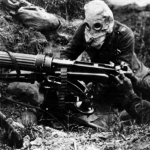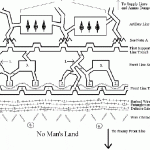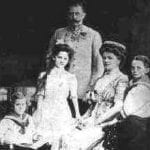The Great War is the watershed between the pre-modern and early modern era. As an example, all we have to do is look at Russia. Before World War One, it was an autocracy, very conservative, very religious, and only a few decades away from serfdom, which the rest of Europe abandoned in the Middle Ages. After the war, it was officially atheistic, communist, rapidly industrializing, and becoming one of two superpowers that dominated the 20th century. To Churchill, the Bolsheviks represented a greater threat to civilized Europe than did the reeking tube and iron shard of the Kaiser’s Reich. Bolshevism, he declared in the House of Commons, was “not a policy; it is a disease. It is not a creed; it is a pestilence.”
-
Background
-
-
The last Russian Tsar, Nicholas II, had come to the throne in 1894.
-
He was not well-suited to be an absolute ruler. He cared deeply about doing his “job” well, but he was a man of modest abilities.
-
In 1905, there had been a revolution in Russia. Nicholas was almost overthrown, but he put the revolution down brutally.
-
After the revolution, soviets (councils) were formed and spread throughout the countryside. They were designed to give people a chance to discuss issues and to have a voice in local government. Leon Trotsky rose to prominence.
-
The revolution prompted Nicholas to allow the formation of the Duma (Parliament), but Nicholas later undermined its functioning. It had very little power.
-
From 1907 to 1911, reforms were introduced in Russia. At the same time, revolutionary movements were forming. Some of these were peasant movements.
-
Another movement was the Marxist Social Democrats, who modeled themselves after the similar movements. Within the Social Democrats were the “Bolsheviks” (the Majority…misleadingly named), who were the most radical.
-
The many disasters suffered by the Russian army during the war greatly undermined Russian morale and loyalty to the government. Discipline broke down as many Russian soldiers “voted with their feet” (deserted).
-
Many Russians were scandalized by the influence that Grigori Rasputin had over the Tsar and Tsarina.
-
- The March Revolution
-
- Broke out spontaneously in March (February under the old calendar) 1917 in St. Petersburg/Petrograd. It took everyone by surprise.
- On March 8, women workers began crying out for food in the streets. They were soon joined by striking workers from the local armaments factory.
- The city garrison was ordered to fire upon the crowd. They refused and instead joined the rebels. The crowd continued to grow.
- On March 15, Nicholas abdicated. This ended three centuries of Romanov rule.
- By mid-March, several former Duma members formed a provisional government. Their goal was to make Russia a republic. But their rule was ineffective. The leader of the P. G. was Alexander Karensky.
- The Provisional Government was not accepted everywhere. It had several rivals, the most significant of which was the soviets, especially the Petrograd Soviet. The Provisional Government tolerated the Petrograd Soviet, but kept a wary eye on it.
- The Rise of the Bolsheviks
-
- Vladimir Lenin, one of the most radical revolutionaries, had been in exile in Switzerland. But in April 1917, the German government, wanting to foment chaos in Russia, sent him to St. Petersburg in a train (but not a “sealed train”, according to Liulevicius).
- Upon arrival in Petrograd, Lenin immediately began giving revolutionary speeches (The “April Theses”). These messages promised that with a further radical revolution, peace, land, and all power to the soviets would become a revolutionary.
- Lenin called for the overthrow of the Provisional Government.
- For Lenin and his followers, the worse things got in Russia, the better. Defeat was necessary. Lenin’s message was shocking to many, but over time, he won many to his position.
- One convert to the Bolshevik movement was Leon Trotsky, who would be a great asset.
- Lenin and the Bolsheviks tried to seize power in July but failed. Lenin fled to Finland, but continued plotting.
- The November Revolution
-
- By October, the Bolsheviks saw that the time was ripe.
- On November 7, they seized power. Red Guard forces stormed the Winter Palace, where the Provisional Government was housed. The Red Guard seized control of the palace and arrested the members of the government.
- The Bolsheviks announced that they were seizing control not for themselves, but on behalf of the soviets.
- In reality, true power was held by the Council of People’s Commissars, a select steering committee led by Lenin.
- The state took over ownership of land, although they allowed and encouraged peasants to occupy it.
- The new government moved to crush all resistance. On December 17, they formed the “All-Russian Extraordinary (or Emergency) Commission for Combating Counter-Revolution and Sabotage under the Council of People’s Commissars of the RSFSR” (CHEKA), the secret police. Their job was to carry out the “Red Terror”…brutalizing, imprisoning, or killing non Bolsheviks and other “enemies of the state.”
- One by one, rival political groups were shut down…even other socialist groups.
- The state took control of factories, internal trade, and land.
- In elections for a Constituent Assembly (called by the Provisional Government before the Communist takeover), the Bolsheviks received only 25% of the vote. They nullified the elections and shut down the assembly.
- On July 16, 1918, the Bolsheviks executed Tsar Nicholas and his family in Yekaterinburg.
- Lenin announced that for now, a dictatorship was needed. He defined dictatorship as “authority untrammeled by any laws, absolutely unrestricted, by any rules whatever, and based directly on force.”
- Lenin and his followers expected communist revolutions to break out in other nations soon after the Russian Revolution. To help promote this, they published all the secret treaties made between Russia and the other European powers.
- The Treaty of Brest-Litovsk
- Soon after taking power,the Bolsheviks announced that Russia was leaving the war. This was a great blow to the western allies. On December 15, they signed a ceasefire with the Central Powers.
- Lenin believed that Russia had to accept defeat in the war and even the loss of territory in order to be able to consolidate the revolution in Russia and eventually promote worldwide revolution.
- On December 22, German and Russian diplomats met at the former Russian fortress of Brest-Litovsk.
- The Bolsheviks were led by Adolph Joffe, who in late December was replaced by Leon Trotsky. In the negotiations, they were not just speaking to the Germans; they were speaking to the world and hoping to inspire revolutions around the world. They were stalling for time.
- (Not long after this, on January 14, a couple of Russian Army soldiers tried to assassinate Lenin…unsuccessfully)
- Before long, the negotiations reached a deadlock. Trotsky got up and walked out. The Germans issued an ultimatum to the Russians: sign the treaty proposed by Germany or face further invasion
- The German army then went on the offensive (“Operation Faustschlag (Fist Punch)”) again, moving quickly eastward and meeting no resistance. They came within 100 miles of Petrograd. German general Max Hoffman wrote “It was the most comical war I have ever known…we put a handful of infantrymen with machine guns and one gun onto a train and rush them off to the next station; they take it, make prisoners of the Bolsheviks, pick up a few more troops and so on. This proceeding has, at my rate, the charm of novelty.” (Keegan, 382)
- Lenin convinced Trotsky and his fellow Bolsheviks that they needed to sign the treaty, no matter how harsh it might be. The alternative might be an even harsher treaty.
- On March 3, the Bolshevik negotiators signed the treaty, which was very harsh on Russia.
- Under the treaty, Russia lost one-third of its territory, one-fourth of its population, 75% of its coal and iron, and its most industrialized areas. It lost Finland, the Baltic States, Ukraine, Byelorussia, and Poland. Germany had to deploy 1 million soldiers to occupy the territories.
- Even though Russia lost a lot in the treaty, Lenin did not mind, since he planned to regain the lost territories eventually.
Cite This Article
"The Russian Revolutions of 1917-1923" History on the Net© 2000-2024, Salem Media.
April 30, 2024 <https://www.historyonthenet.com/the-russian-revolutions-of-1917-1923>
More Citation Information.








